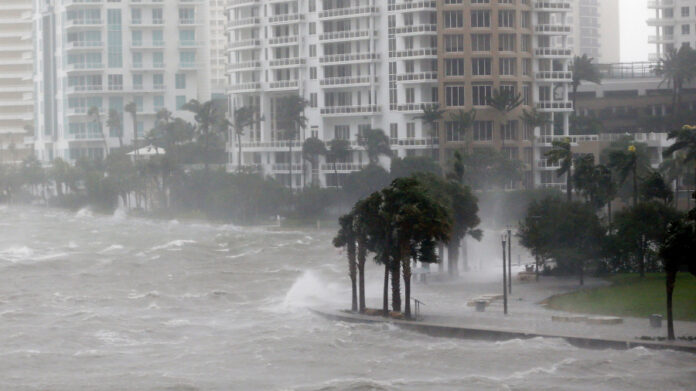TAMPA, Fla. (WFLA) – It’s been three years since Florida found itself bracing for what ended up being one of the Atlantic basin’s strongest and costliest hurricanes on record.
Hurricane Irma was a long-lived system from Aug. 30 to Sept. 12, 2017. The storm ended up making a total of seven landfalls.
Irma’s formation
According to the National Hurricane Center, Irma started as a tropical wave that emerged off the coast of Africa on Aug. 27, 2017. By 12 a.m. UTC on Aug. 30, the NHC noted that satellite images showed a well-defined surface circulation on the system and said it likely became a tropical depression around that time.
Just about six hours later, the NHC said Irma had strengthened to become a tropical storm.
Rapid intensification
Irma started to intensify rapidly as it moved over the eastern Atlantic. The NHC said the quick strengthening was thanks to low vertical wind shear, a “fairly moist” lower troposphere and warm sea surface temperatures.
Irma became a hurricane and developed a “ragged eye” around 2 a.m. ET on Aug. 30 – just about 30 hours after it had formed as a tropical depression.
Later that day, Irma reached major hurricane strength.
“This 70-kt increase in intensity over a 48-hour period is a remarkable rate that is only achieved by a small fraction of Atlantic tropical cyclones,” the NHC noted.
Irma’s strength ended up fluctuating in the following days as it continued its trek across the Atlantic, weakening to a Category 2 storm at times before strengthening again to become Category 3.
The NHC noted that Irma’s eye grew in size and became better defined by early Sept. 4, which led to more strengthening.
Impact on the islands
Hurricane Irma made its first landfall in the early morning hours of Sept. 6 on Barbuda. Just hours later, a second landfall was reported on St. Martin followed by a third landfall on the Island of Virgin Gorda in the British Virgin Islands.
According to the NHC, Hurricane Irma was at its peak intensity of 155 knots, a Category 5 hurricane, for all three of those landfalls.
Irma weakened slightly and made landfall on Little Inagua Island in the Bahamas early Sept. 8. It was a Category 4 hurricane at the time.
The storm then restrengthened as it moved toward Cuba and ended up reaching Category 5 strength once more when it made its fifth landfall near Cayo Romano overnight.
Trek toward Florida
After Irma’s landfall in Cuba, the hurricane weakened significantly to Category 2 strength. But once it reached the Florida Straits early on Sept. 10 and started moving over the warm waters, it intensified once more to a Category 4 hurricane.
In the hours that led up to Irma’s arrival in Florida, millions of people in the Tampa Bay area were left on edge as they prepared and watched the track closely. Rick Scott, who was governor at the time, had declared a state of emergency in all of Florida’s counties on Sept. 4. All tolls were suspended as well to help any Floridians who decided to evacuate.
Irma eventually made landfall in the Florida Keys around 9 a.m. on Sept. 10. It slammed Cudjoe Key as a Category 4 storm then weakened to Category 3 strength.
Hurricane Irma made a final landfall near Marco Island, Florida the afternoon just a few hours later.
Quick weakening over Florida
Once Irma started moving inland and over Florida, the storm weakened quickly.
Irma moved east of Naples late Sept. 10 as a Category 2 hurricane before passing between Tampa and Orlando as a Category 1 in the early hours of Sept. 11.
Irma eventually weakened to a tropical storm near Gainesville.
Deadly and destructive storm
According to a report from the NHC, Irma caused 47 direct deaths as a result of strong winds, heavy rains and high surf across the Caribbean Islands and southeastern United States.
The United States reported 10 direct deaths from Irma as well as 82 indirect deaths. Of the indirect deaths in the U.S., 77 happened in Florida.
One of the direct deaths in the U.S., according to the NHC, was an 89-year-old Manatee County man who drowned when he went outside during the hurricane to secure his boat to a dock and fell into a canal.
The NHC also noted that approximately 6 million Florida residents evacuated from coastal areas.
According to the NHC’s report, Irma was the fifth-costliest hurricane to impact the United States behind Katrina in 2005, Harvey and Maria in 2017 and Sandy in 2012.
In Florida, the most severe damage was reported in the Keys. The NHC says most homes in the Middle and Lower Keys were badly damaged or destroyed.
READ: Full Tropical Cyclone Report on Hurricane Irma from the NHC
LATEST NEWS FROM WFLA.COM:














